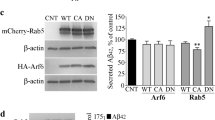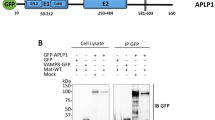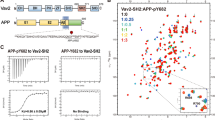Abstract
Protein kinase C (PKC) has a key role in the signal transduction machinery involved in the regulation of amyloid precursor protein (APP) metabolism. Direct and indirect receptor-mediated activation of PKC has been shown to increase the release of soluble APP (sAPPα) and reduce the secretion of β-amyloid peptides. Experimental evidence suggests that specific isoforms of PKC, such as PKCα and PKCɛ, are involved in the regulation of APP metabolism. In this study, we characterized the role of PKCα in the regulated secretion of APP using wild-type SH-SY5Y neuroblastoma cells and cells transfected with a plasmid expressing PKCα antisense cDNA. Cells expressing antisense PKCα secrete less sAPPα in response to phorbol esters. In contrast, carbachol increases the secretion of sAPPα to similar levels in wild-type cells and in cells transfected with antisense PKCα by acting on APP metabolism through an indirect pathway partially involving the activation of PKC. These results suggest that the direct PKC-dependent activation of the APP secretory pathway is compromised by reduced PKCα expression and a specific role of this isoform in these mechanisms. On the other hand, indirect pathways that are also partially dependent on the mitogen-activated protein kinase signal transduction mechanism remain unaffected and constitute a redundant, compensatory mechanism within the APP secretory pathway.
This is a preview of subscription content, access via your institution
Access options
Subscribe to this journal
Receive 12 print issues and online access
$259.00 per year
only $21.58 per issue
Buy this article
- Purchase on Springer Link
- Instant access to full article PDF
Prices may be subject to local taxes which are calculated during checkout






Similar content being viewed by others
References
Selkoe DJ . Translating cell biology into therapeutic advances in Alzheimer's disease. Nature 1999; 399 (6738 Suppl): A23–A31.
Buxbaum JD, Liu KN, Luo Y, Slack JL, Stocking KL, Peschon JJ et al. Evidence that tumor necrosis factor alpha converting enzyme is involved in regulated alpha-secretase cleavage of the Alzheimer amyloid protein precursor. J Biol Chem 1998; 273: 27 765–27 767.
Lammich S, Kojro E, Postina R, Gilbert S, Pfeiffer R, Jasionowski M et al. Constitutive and regulated alpha-secretase cleavage of Alzheimer's amyloid precursor protein by a disintegrin metalloprotease. Proc Natl Acad Sci USA 1999; 96: 3922–3927.
Vassar R, Bennett BD, Babu-Khan S, Kahn S, Mendiaz EA, Denis P et al. Beta-secretase cleavage of Alzheimer's amyloid precursor protein by the transmembrane aspartic protease BACE. Science 1999; 286: 735–741.
Wolfe MS, Xia W, Ostaszewski BL, Diehl TS, Kimberly WT, Selkoe DJ . Two transmembrane aspartates in presenilin-1 required for presenilin endoproteolysis and gamma-secretase activity. Nature 1999; 398: 513–517.
Mills J, Reiner PB . Regulation of amyloid precursor protein cleavage. J Neurochem 1999; 72: 443–460.
Racchi M, Govoni S . Rationalizing a pharmacological intervention on the amyloid precursor protein metabolism. TIPS 1999; 20: 418–423.
Pascale A, Govoni S, Battaini F . Age-related alteration of PKC, a key enzyme in memory processes: physiological and pathological examples. Mol Neurobiol 1998; 16: 49–62.
Wang HY, Pisano MR, Friedman E . Attenuated protein kinase C activity and translocation in Alzheimer's disease brain. Neurobiol Aging 1994; 15: 293–298.
Govoni S, Bergamaschi S, Racchi M, Battaini F, Binetti G, Bianchetti A et al. Cytosol protein kinase C downregulation in fibroblasts from Alzheimer's disease patients. Neurology 1993; 43: 2581–2586.
Bergamaschi S, Binetti G, Govoni S, Wetsel WC, Battaini F, Trabucchi M et al. Defective phorbol ester-stimulated secretion of beta-amyloid precursor protein from Alzheimer's disease fibroblasts. Neurosci Lett 1995; 201: 1–5.
Nitsch RM, Slack BE, Wurtman RJ, Growdon JH . Release of Alzheimer amyloid precursor derivatives stimulated by activation of muscarinic acetylcholine receptors. Science 1992; 258: 304–307.
Haring R, Fisher A, Marciano D, Pittel Z, Kloog Y, Zuckerman A et al. Mitogen-activated protein kinase-dependent and protein kinase C-dependent pathways link the m1 muscarinic receptor to beta-amyloid precursor protein secretion. J Neurochem 1998; 71: 2094–2103.
Slack BE, Breu J, Petryniak MA, Srivastava K, Wurtman RJ . Tyrosine phosphorylation-dependent stimulation of amyloid precursor protein secretion by the m3 muscarinic acetylcholine receptor. J Biol Chem 1995; 270: 8337–8344.
Boyce JJ, Shea TB . Phosphorylation events mediated by protein kinase C alpha and epsilon participate in regulation of tau steady-state levels and generation of certain ‘Alzheimer-like’ phospho-epitopes. Int J Dev Neurosci 1997; 15: 295–307.
Leli U, Parker PJ, Shea TB . Intracellular delivery of protein kinase C-alpha or -epsilon isoform-specific antibodies promotes acquisition of a morphologically differentiated phenotype in neuroblastoma cells. FEBS Lett 1992; 297: 91–94.
Lambert DG, Ghataorre AS, Nahorski SR . Muscarinic receptor binding characteristics of a human neuroblastoma SK-N-SH and its clones SH-SY5Y and SH-EP1. Eur J Pharmacol 1989; 165: 71–77.
Serra M, Mei L, Roeske WR, Lui GK, Watson M, Yamamura HI . The intact human neuroblastoma cell (SH-SY5Y) exhibits high-affinity [3 H]pirenzepine binding associated with hydrolysis of phosphatidylinositols. J Neurochem 1988; 50: 1513–1521.
Racchi M, Solano DC, Sironi M, Govoni S . Activity of alpha-secretase as the common final effector of protein kinase C-dependent and -independent modulation of amyloid precursor protein metabolism. J Neurochem 1999; 72: 2464–2470.
Racchi M, Sironi M, Caprera A, König G, Govoni S . Short and long term effect of acetylcholinesterase inhibition on the expression and metabolism of the amyloid precursor protein. Mol Psychiatry 2001; 6: 520–528.
Gabev E, Kasianowicz J, Abbott T, McLaughlin S . Binding of neomycin to phosphatidylinositol 4,5-bisphosphate (PIP2). Biochim Biophys Acta 1989; 979: 105–112.
LeBlanc AC, Koutroumanis M, Goodyer CG . Protein kinase C activation increases release of secreted amyloid precursor protein without decreasing beta production in human primary neuron cultures. J Neurosci 1998; 18: 2907–2913.
Vestling M, Cedazo-Minguez A, Adem A, Wiehager B, Racchi M, Lannfelt L et al. Protein kinase C and amyloid precursor protein processing in skin fibroblasts from sporadic and familial Alzheimer's disease cases. Biochim Biophys Acta 1999; 1453: 341–350.
Gasparini L, Racchi M, Binetti G, Trabucchi M, Solerte SB, Alkon D et al. Peripheral markers in testing pathophysiological hypotheses and diagnosing Alzheimer's disease. FASEB J 1998; 12: 17–34.
Kazanietz MG, Areces LB, Bahador A, Mischak H, Goodnight J, Mushinski JF et al. Characterization of ligand and substrate specificity for the calcium-dependent and calcium-independent protein kinase C isozymes. Mol Pharmacol 1993; 44: 298–307.
Slack BE, Nitsch RM, Livneh E, Kunz Jr GM, Breu J, Eldar H et al. Regulation by phorbol esters of amyloid precursor protein release from Swiss 3T3 fibroblasts over expressing protein kinase C alpha. J Biol Chem 1993; 268: 21 097–21 101.
Benussi L, Govoni S, Gasparini L, Binetti G, Trabucchi M, Bianchetti A et al. Specific role for protein kinase C alpha in the constitutive and regulated secretion of amyloid precursor protein in human skin fibroblasts. Neurosci Lett 1998; 240: 97–101.
Jolly-Tornetta C, Wolf BA . Regulation of amyloid precursor protein (APP) secretion by protein kinase C alpha in human ntera 2 neurons (NT2N). Biochemistry 2000; 39: 7428–7435.
Kinouchi T, Sorimachi H, Maruyama K, Mizuno K, Ohno S, Ishiura S et al. Conventional protein kinase C (PKC)-alpha and novel PKC epsilon, but not -delta, increase the secretion of an N-terminal fragment of Alzheimer's disease amyloid precursor protein from PKC cDNA transfected 3Y1 fibroblasts. FEBS Lett 1995; 364: 203–206.
Yeon SW, Jung MW, Ha MJ, Kim SU, Huh K, Savage MJ et al. Mook-Jung blockade of PKC epsilon activation attenuates phorbol ester-induced increase of alpha-secretase-derived secreted form of amyloid precursor protein. Biochem Biophys Res Comm 2001; 280: 782–787.
Zhu G, Wang D, Lin YH, McMahon T, Koo EH, Messing RO . Protein kinase C epsilon suppresses beta production and promotes activation of alpha-secretase. Biochem Biophys Res Comm 2001; 285: 997–1006.
Slack BE . The m3 muscarinic acetylcholine receptor is coupled to mitogen-activated protein kinase via protein kinase C and epidermal growth factor receptor kinase. Biochem J 2000; 348: 381–387.
Desdouits-Magnen J, Desdouits F, Takeda S, Syu LJ, Saltiel AR, Buxbaum JD et al. Regulation of secretion of Alzheimer amyloid precursor protein by the mitogen-activated protein kinase cascade. J Neurochem 1998; 70: 524–530.
Mills J, Laurent Charest D, Lam F, Beyreuther K, Ida N, Pelech SL et al. Regulation of amyloid precursor protein catabolism involves the mitogen-activated protein kinase signal transduction pathway. J Neurosci 1997; 17: 9415–9422.
Kim JY, Yang MS, Oh CD, Kim KT, Ha MJ, Kang SS et al. Signalling pathway leading to an activation of mitogen-activated protein kinase by stimulating M3 muscarinic receptor. Biochem J 1999; 337: 275–280.
Acknowledgements
We are grateful to Dr Thomas B Shea for the gift of SH-SY5Y cells transfected with antisense PKCα (SYα4) and the parental non-transfected SH-SY5Y cell line (SYwt). We are also grateful to Prof. Mark O Lively of Wake Forest University School of Medicine, Winston Salem, NC, USA for helpful discussions and a careful proofreading of the manuscript. The financial support of TELETHON—Italy, Grant # E.0866 to SG is gratefully acknowledged. This research was also funded by MIUR—Cofin 2000 (SG) and Ministero Sanità—Progetto Alzheimer (MR).
Author information
Authors and Affiliations
Corresponding author
Rights and permissions
About this article
Cite this article
Racchi, M., Mazzucchelli, M., Pascale, A. et al. Role of protein kinase Cα in the regulated secretion of the amyloid precursor protein. Mol Psychiatry 8, 209–216 (2003). https://doi.org/10.1038/sj.mp.4001204
Received:
Revised:
Accepted:
Published:
Issue Date:
DOI: https://doi.org/10.1038/sj.mp.4001204
Keywords
This article is cited by
-
The complex world of post-transcriptional mechanisms: is their deregulation a common link for diseases? Focus on ELAV-like RNA-binding proteins
Cellular and Molecular Life Sciences (2012)
-
Bryostatin-1 vs. TPPB: Dose-Dependent APP Processing and PKC-α, -δ, and -ε Isoform Activation in SH-SY5Y Neuronal Cells
Journal of Molecular Neuroscience (2012)
-
The significance of the cholinergic system in the brain during aging and in Alzheimer’s disease
Journal of Neural Transmission (2006)
-
GM1 ganglioside regulates the proteolysis of amyloid precursor protein
Molecular Psychiatry (2004)



